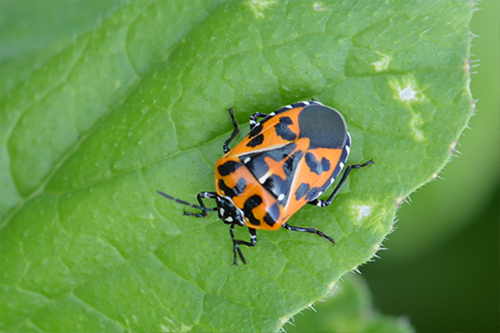Harlequin Bugs
 About Harlequin Bugs
About Harlequin Bugs
This insect can be found throughout the southern regions of North America, with their range rarely exceeding north of Pennsylvania. In West Virginia, this insect likely has two generations per year. Adults remain throughout the winter, often seeking shelter in crop residues and other organic debris such as dead leaves, mulch or bunches of grass. Adults begin depositing eggs about two weeks after becoming active in the spring.
Harlequin Bug Description
Harlequin bugs are in the stink bug family and are black with bright red, yellow or orange markings.
Harlequin Bug Damage
The harlequin bug, Murgantia histrionica, is an insect pest of vegetable crops in the family Brassicaceae. Plants commonly attacked by this insect include broccoli, Brussels sprouts, cabbage, cauliflower, collards, kale, kohlrabi, mustard, radish and turnips. This pest injures host plants by sucking the fluids from plant tissue. This can result in yellow or white blotches at the feeding site and wilted or deformed plants. Heavy infestations can cause plants to turn brown and die.
Harlequin Bug Control
Cultural and chemical controls can be used to manage harlequin bugs. Destruction of crop residues in the fall is an important cultural practice to limit harlequin bug damage for the following year. Because this insect can also feed and reproduce on wild, weedy mustards (e.g. pepperweed, shepherd’s purse, wild mustard), it is also important to keep weeds under control in fields and along field edges. In the southern United States where the harlequin bug is a serious pest, trap crops consisting of early planted horseradish, kale, mustard or rapeseed have been used to divert overwintering populations. These crops are then sprayed or destroyed before the primary crop becomes susceptible to attack. Chemical options for control of harlequin bugs include numerous compounds in the pyrethroid (e.g., beta-cyfluthrin, bifenthrin, lambda-cyhalothrin) and neonicotinoid (e.g., acetamiprid and clothianidin) class of insecticides; pyrethrins are permissible in organic production.
Recently, the harlequin bug has been observed more frequently in West Virginia. Although it is unclear why these insects are becoming increasingly problematic, growers introducing fewer brassica-free periods during the season and/or growers not initiating a strong weed management program may be contributing to its abundance on farms.
Author: Daniel Frank, former WVU Extension Entomology Specialist
Last Reviewed: May 23, 2017